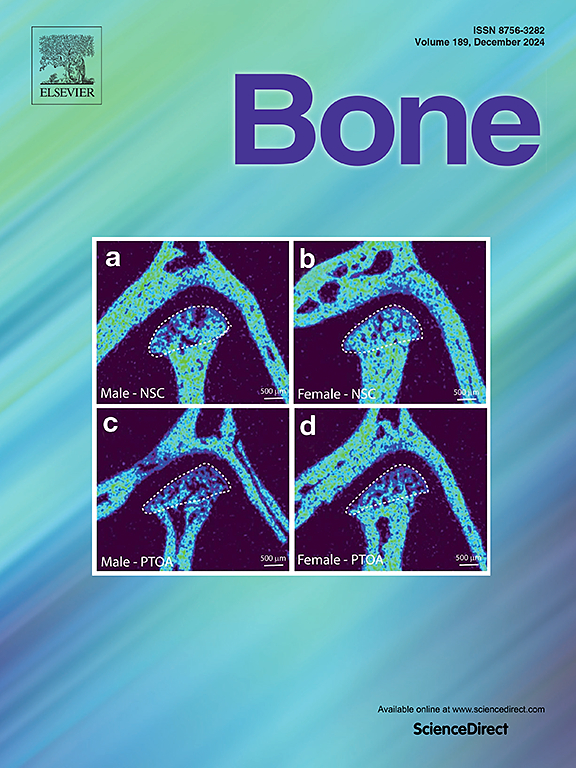在2岁以下的儿童中,有和没有成骨不全症的儿童的骨健康指数值有差异吗?
IF 3.5
2区 医学
Q2 ENDOCRINOLOGY & METABOLISM
引用次数: 0
摘要
背景:在两岁以下不明原因骨折的儿童中,可能很难区分那些由于成骨不全症(OI)等情况导致的低骨密度(BMD)与那些遭受虐待的儿童。目前,没有一种成像方式可以方便或可靠地评估该年龄组的骨密度或骨强度。目的:探讨骨健康指数(BHI)和骨健康指数标准差评分(SDS)是否有足够的敏感性来区分2岁以下儿童有无成骨不全。方法:在这项回顾性的初步研究中,我们使用BoneXpert软件测量了122张x线片(33张成骨不全,89张疑似滥用)的BHI和BHI SDS。除临床诊断、敏感性、特异性和受试者工作特征(ROC)曲线外,还采用标准统计方法(t检验、Pearson相关)。结果:无成骨不全组BHI显著高于成骨不全组,分别为3.75和3.41 (p = 0.003)。OI / non-OI组的儿童的比例与BHI ≤ 2.49,2.5 - -2.99,3 - 3.49,和≥4 0 % / 0 %,27 % / 7 %,58 % / 28 %,18 % / 29 %,分别和12 % / 36 %。无成骨不全组BHI SDS明显高于成骨不全组,分别为-0.039和-0.451 (p = 0.01),但两组BHI SDS均在正常范围内(±2)。结论:虽然成骨不全儿童的BHI SDS较低,但仍在正常范围内。没有成骨不全的婴儿有更好的体积骨密度,与更强壮的骨骼相关。这表明BHI可以用来区分骨密度低的儿童和骨骼健康的儿童。临床医生可能会发现本研究中建立的分界点有助于评估BHI在检测成骨不全和识别非成骨不全个体方面的敏感性和特异性。需要进一步的研究来评估BHI在这个年龄组的临床应用。本文章由计算机程序翻译,如有差异,请以英文原文为准。
In children under two years of age, does the bone health index value differ between those with and without osteogenesis imperfecta?
Background
In children with unexplained fractures who are below the age of two years, it may be difficult to distinguish those with low bone mineral density (BMD) due to conditions such as osteogenesis imperfecta (OI) from those who have been abused. Currently, no imaging modality can readily or reliably assess BMD or evaluate bone strength in this age group.
Aim
To investigate whether bone health index (BHI) and bone health index standard deviation scores (SDS) are sufficiently sensitive to distinguish between children under two years old with and without OI.
Methods
In this retrospective pilot study, we measured BHI and BHI SDS from 122 radiographs (33 OI, 89 suspected abuse) using BoneXpert software. Standard statistical methods (t-test, Pearson's correlation) were applied in addition to clinical diagnostics, sensitivity, specificity, and receiver operating characteristic (ROC) curves. An arbitrary level of p < 0.05 was assumed.
Results
BHI was significantly greater in the group without OI compared to the group with OI, 3.75 and 3.41, respectively (p = 0.003). The percentage of children in the OI/non-OI groups with BHI ≤ 2.49, 2.5–2.99, 3–3.49, and ≥4 was 0 %/0 %, 27 %/7 %, 58 %/28 %, 18 %/29 %, and 12 %/36 %, respectively. While BHI SDS was significantly greater in the group without OI compared to the group with OI, −0.039 and −0.451, respectively (p = 0.01), BHI SDS was within the normal range (±2) for both groups.
Conclusion
Although BHI SDS is lower in OI children, it remained within the normal range. Infants without OI had better volumetric bone mineral density, associated with stronger bones. This suggests BHI might be used to differentiate between young children with low BMD and those with healthy bones. Clinicians may find the cut-points established in this study useful for assessing the sensitivity and specificity of BHI in detecting OI and identifying individuals without OI. Further research is needed to assess BHI's clinical utility in this age group.
求助全文
通过发布文献求助,成功后即可免费获取论文全文。
去求助
来源期刊

Bone
医学-内分泌学与代谢
CiteScore
8.90
自引率
4.90%
发文量
264
审稿时长
30 days
期刊介绍:
BONE is an interdisciplinary forum for the rapid publication of original articles and reviews on basic, translational, and clinical aspects of bone and mineral metabolism. The Journal also encourages submissions related to interactions of bone with other organ systems, including cartilage, endocrine, muscle, fat, neural, vascular, gastrointestinal, hematopoietic, and immune systems. Particular attention is placed on the application of experimental studies to clinical practice.
 求助内容:
求助内容: 应助结果提醒方式:
应助结果提醒方式:


